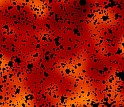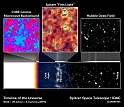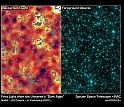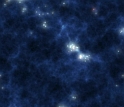News Release 06-175
Universe's Oldest Objects Emerge from the Background
Faint cosmic glow appears to be remnant radiation from first stars or black holes born in our universe
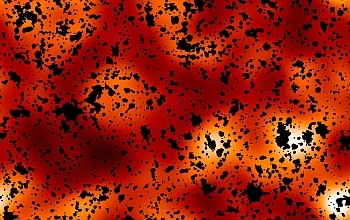
View video
After several image processing steps, ancient objects emerge from the flood of cosmic light.
December 18, 2006
This material is available primarily for archival purposes. Telephone numbers or other contact information may be out of date; please see current contact information at media contacts.
The deepest reaches of space are permeated by a cloak of infrared radiation, an uneven energy swath generated by long-dead objects from the early universe.
Now, researchers have teased apart overlapping signals from that cosmic infrared background, building upon an earlier study to show that uneven patches of energy may actually be clusters of the first objects to emerge from the Big Bang.
The astronomers believe the objects are either extremely bright stars more than 1,000 times more massive than our sun, or quasars, large black holes that consume enormous amounts of gas and debris and re-emit the materials in almost unparalleled bursts of energy. If the patches are star clusters, they may be the first galaxies, smaller than most known galaxies yet containing a mass on the scale of 1 million suns.
With a grant from the National Science Foundation, researchers studied archival data from the calibration of the NASA Spitzer telescope and conducted several stages of cleaning to remove signals from more recent galaxies and other objects to get to the underlying signals.
"Observing the cosmic infrared background is like watching distant fireworks from within a brightly lit city," said lead author Alexander Kashlinsky of NASA's Goddard Space Flight Center in Greenbelt, Md. "It's as if we have turned off the city lights one by one to see the bursts more clearly. While we can't resolve each spark in the fireworks, we can see the large scale structures and their glow."
The new study added observations of four regions of the night sky, two from each hemisphere, to data the telescope collected during a calibration last year. The new observations, with exposure times of up to 25-26 hours per pixel, peered four times deeper into the universe than the earlier effort and greatly expanded the observation area.
Kashlinsky, Richard Arendt, John Mather and S. Harvey Moseley all from Goddard, will publish their findings in two papers in the Jan. 1, 2007, Astrophysical Journal. Co-author Mather shared the 2006 Nobel Prize for Physics for work on another form of background radiation, the cosmic microwave background.
The research was supported by NSF award AST-0406587 and NASA grant Spitzer NM0710076. Science support to NASA Goddard is supplied by Science Systems and Applications, Inc.
Additional information, illustrations and animations are available in the Jet Propulsion Laboratory press release at: http://www.spitzer.caltech.edu/Media/releases/ssc2006-22/
-NSF-
-
View Video
This animation represents data collected at a wavelength of 4.5 microns.
Credit and Larger Version -
Artist's timeline chronicling the history of the universe.
Credit and Larger Version -
Before data processing, stars and galaxies drown out the infrared background radiation.
Credit and Larger Version -
View Video
Over the first billion years of the universe, stars were born.
Credit and Larger Version
Media Contacts
Joshua A. Chamot, NSF, (703) 292-7730, email: jchamot@nsf.gov
Gordon Squires, Spitzer Science Center, (626) 395-3121, email: squires@ipac.caltech.edu
Whitney Clavin, Jet Propulsion Laboratory, (818) 354-4673, email: Whitney.Clavin@jpl.nasa.gov
Program Contacts
Nigel A. Sharp, NSF, (703) 292-4905, email: nsharp@nsf.gov
Principal Investigators
Alexander Kashlinsky, SSAI, (301) 286 2176, email: kash@milkyway.gsfc.nasa.gov
The U.S. National Science Foundation propels the nation forward by advancing fundamental research in all fields of science and engineering. NSF supports research and people by providing facilities, instruments and funding to support their ingenuity and sustain the U.S. as a global leader in research and innovation. With a fiscal year 2023 budget of $9.5 billion, NSF funds reach all 50 states through grants to nearly 2,000 colleges, universities and institutions. Each year, NSF receives more than 40,000 competitive proposals and makes about 11,000 new awards. Those awards include support for cooperative research with industry, Arctic and Antarctic research and operations, and U.S. participation in international scientific efforts.
Connect with us online
NSF website: nsf.gov
NSF News: nsf.gov/news
For News Media: nsf.gov/news/newsroom
Statistics: nsf.gov/statistics/
Awards database: nsf.gov/awardsearch/
Follow us on social
Twitter: twitter.com/NSF
Facebook: facebook.com/US.NSF
Instagram: instagram.com/nsfgov



